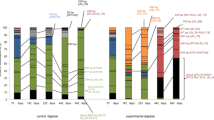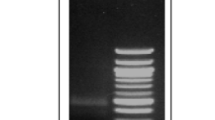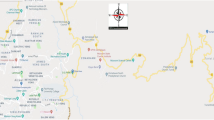Abstract
Short-chain fatty acids (SCFAs) can be produced by primary and waste activated sludge anaerobic fermentation. The yield and product spectrum distribution of SCFAs can be significantly affected by different initial pH values. However, most studies have focused on the physical and chemical aspects of SCFA production by waste activated sludge fermentation at different pH values. Information on the bacterial community structures during acidogenic fermentation is limited. In this study, comparisons of the bacterial communities during the co-substrate fermentation of food wastes and sewage sludge at different pH values were performed using the barcoded Illumina paired-end sequencing method. The results showed that different pH environments harbored a characteristic bacterial community, including sequences related to Lactobacillus, Prevotella, Mitsuokella, Treponema, Clostridium, and Ureibacillus. The most abundant bacterial operational taxonomic units in the different pH environments were those related to carbohydrate-degrading bacteria, which are associated with constituents of co-substrate fermentation. Further analyses showed that during organic matter fermentation, a core microbiota composed of Firmicutes, Proteobacteria, and Bacteroidetes existed. Comparison analyses revealed that the bacterial community during fermentation was significantly affected by the pH, and that the diverse product distribution was related to the shift in bacterial communities.





Similar content being viewed by others
References
Ahn YH, Speece RE (2006) Elutriated acid fermentation of municipal primary sludge. Water Res 40:2210–2220
Akarsubasi AT, Ince O, Kirdar B, Oz NA, Orhon D, Curtis TP, Head IM, Ince BK (2005) Effect of wastewater composition on archaeal population diversity. Water Res 39:1576–1584
Chen H, Wu H (2010) Optimization of volatile fatty acid production with co-substrate of food wastes and dewatered excess sludge using response surface methodology. Bioresour Technol 101:5487–5493
Chen Y, Yuan H, Zhou Q, Gu G (2007) Hydrolysis and acidification of waste activated sludge at different pHs. Water Res 41:683–689
Cirne DG, Bond P, Pratt S, Lant P, Batstone DJ (2011) Microbial community analysis during continuous fermentation of thermally hydrolysed waste activated sludge. Water Sci Technol 65(1):7–14
Dubois M, Gilles KA, Hamilton JK, Rebers PA, Smith F (1956) Colorimetric method for determination of sugars and related substances. Anal Chem 28:350–356
Feng LY, Chen YG, Zheng X (2009) Enhancement of waste activated sludge protein conversion and volatile fatty acids accumulation during waste activated sludge anaerobic fermentation by carbohydrate substrate addition: the effect of pH. Environ Sci Technol 43:4373–4380
Grady CPL, Daigger GT, Lim HC (1999) Biological wastewater treatment, 2nd edn. Marcel Dekker Inc., New York
Hong PY, Wheeler E, Cann IK, Mackie RI (2011) Phylogenetic analysis of the fecal microbial community in herbivorous land and marine iguanas of the Gala´pagos Islands using 16S rRNA-based pyrosequencing. ISME J 5:1461–1470
Horiuchi J, Shimizu T, Kanno T, Kobayashi M (1999) Dynamic behavior in response to pH shift during anaerobic acidogenesis with a chemostat culture. Biotechnol Tech 13:155–157
Im WT, Kim DH, Kim KH, Kim MS (2012) Bacterial community analyses by pyrosequencing in dark fermentative H2-producing reactor using organic wastes as a feedstock. Int J Hydrogen Energy 37:8330–8337
Kim HJ, Kim SH, Choi YG, Kim GD, Chung TH (2006) Effect of enzymatic pretreatment on acid fermentation of food waste. J Chem Technol Biotechnol 81:974–980
Lim SJ, Choi DW, Lee WG, Kwon S, Chang HN (2000) Volatile fatty acids production from food wastes and its application to biological nutrient removal. Bioprocess Eng 22:543–545
Lim SJ, Kim BJ, Jeong CM, Choi J, Ahn YH, Chang HN (2008) Anaerobic organic acid production of food waste in once-a-day feeding and drawing-off bioreactor. Bioresour Technol 99:7866–7874
Liu WT, Chan OC, Fang HHP (2002) Microbial community dynamics during start-up of acidogenic anaerobic reactors. Water Res 36:3203–3210
Liu H, Wang J, Liu X, Fu B, Chen J, Yu HQ (2012) Acidogenic fermentation of proteinaceous sewage sludge: effect of pH. Water Res 46:799–807
Lowry OH, Rosenbrough NJ, Farr AL, Randall RJ (1951) Protein measurement with the Folin phenol reagent. J Biol Chem 193:265–275
Macy JM, Ljungdahl LG, Gottschalk G (1978) Pathway of Succinate and Propionate Formation in Bacteroides fragilis. J Bacteriol 134:84–91
Miron Y, Zeeman G, Van Lier JB, Lettinga G (2000) The role of sludge retention time in the hydrolysis and acidification of lipids, carbohydrates and proteins during digestion of primary sludge in CSTR systems. Water Res 34:1705–1713
Murray A, Horvath A, Nelson K (2008) Hybrid life-cycle environmental and cost inventory of sewage sludge treatment and end-use scenarios: a case study from China. Environ Sci Technol 42:3163–3169
Shokralla S, Spall JL, Gibson JF, Hajibabaei M (2012) Next-generation sequencing technologies for environmental DNA research. Mol Ecol 21(8):1794–1805
Suwannakham S, Yang ST (2005) Enhanced propionic acid fermentation by Propionibacterium acidipropionici mutant obtained by adaptation in a fibrous-bed bioreactor. Biotechnol Bioeng 91(3):325–337
Tilman D, Reich PB, Knops JMH (2006) Biodiversity and ecosystem stability in a decade-long grassland experiment. Nature 441(7093):629–632
Van Wegen RJ, Ling Y, Middelberg APJ (1998) Industrial production of polyhydroxyalkanoates using Escherichia coli: an economic analysis. Chem Eng Res Des 76:417–426
Ventura M, Canchaya C, Tauch A, Chandra G, Fitzgerald GF et al (2007) Genomics of Actinobacteria: tracing the evolutionary history of an ancient phylum. Microbiol Mol Biol Rev 71:495–548
Werner JJ, Zhou D, Caporaso G, Knight R, Angenent LT (2012) Comparison of Illumina paired-end and single-direction sequencing for microbial 16S rRNA gene amplicon surveys. ISME J 6(7):1273–6
Wijekoon KC, Visvanathan C, Abeynayaka A (2011) Effect of organic loading rate on VFA production, organic matter removal and microbial activity of a two-stage thermophilic anaerobic membrane bioreactor. Bioresour Technol 102:5353–5360
Wittebolle L, Marzorati M, Clement L, Balloi A, Daffonchio D, Heylen K, Devos P, Verstraete W, Boon N (2009) Initial community evenness favours functionality under selective stress. Nature 458(7238):623–626
Wrighton KC, Virdis B, Clauwaert P, Read ST, Daly RA, Boon N, Piceno Y, Andersen GL, Coates JD, Rabaey K (2010) Bacterial community structure corresponds to performance during cathodic nitrate reduction. ISME J 4(11):1443–1455
Ye FN, Lü F, Shao LM, Godon JJ, He PJ (2007) Bacterial community dynamics and product distribution during pH-adjusted fermentation of vegetable wastes. J Appl Microbiol 103:1055–1065
Ye L, Shao MF, Zhang T, Tong AHY, Lok S (2011) Analysis of the bacterial community in a laboratory-scale nitrification reactor and a wastewater treatment plant by 454-pyrosequencing. Water Res 45:4390–4398
Yuan H, Chen Y, Zhang H, Jiang S, Zhou Q, Gu G (2006) Improved bioproduction of short-chain fatty acids (SCFAs) from excess sludge under alkaline conditions. Environ Sci Technol 40(6):2025–2029
Yuan Q, Sparling R, Oleszkiewicz JA (2011) VFA generation from waste activated sludge: effect of temperature and mixing. Chemosphere 82:603–607
Zhang P, Chen Y, Zhou Q (2009) Waste activated sludge hydrolysis and short-chain fatty acids accumulation under mesophilic and thermophilic conditions: effect of pH. Water Res 43:3735–3742
Zhang P, Chen Y, Zhou Q, Zheng X, Zhu X, Zhao Y (2010) Understanding short-chain fatty acids accumulation enhanced in waste activated sludge alkaline fermentation: kinetics and microbiology. Environ Sci Technol 44:9343–9348
Zhou HW, Li DF, Tam NFY, Jiang XT, Zhang H, Sheng HF, Qin J, Liu X, Zou F (2010) BIPES, a cost-effective high-throughput method for assessing microbial diversity. ISME J 5(4):741–9
Zhu Y, Yang ST (2004) Effect of pH on metabolic pathway shift in fermentation of xylose by Clostridium tyrobutyricum. J Biotechnol 110:143–157
Acknowledgments
The authors are grateful to the support from Science and Technology Department of Zhejiang Province (2012C23043), Natural Science Foundation of China (No. 21277117 and No. 21210008).
Author information
Authors and Affiliations
Corresponding author
Electronic supplementary material
Below is the link to the electronic supplementary material.
Rights and permissions
About this article
Cite this article
Cheng, W., Chen, H., Yan, S. et al. Illumina sequencing-based analyses of bacterial communities during short-chain fatty-acid production from food waste and sewage sludge fermentation at different pH values. World J Microbiol Biotechnol 30, 2387–2395 (2014). https://doi.org/10.1007/s11274-014-1664-6
Received:
Accepted:
Published:
Issue Date:
DOI: https://doi.org/10.1007/s11274-014-1664-6




